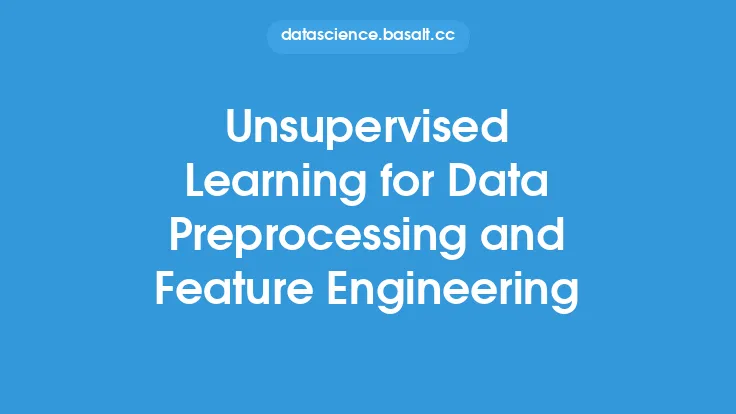High-dimensional data, characterized by a large number of features or variables, poses significant challenges in data mining and machine learning. The curse of dimensionality, a phenomenon where high-dimensional data becomes increasingly sparse and difficult to analyze, can lead to poor model performance, overfitting, and increased computational costs. Feature engineering, the process of selecting and transforming raw data into relevant features that can be used in machine learning models, is crucial for mitigating these challenges. In this article, we will delve into the strategies and tools for feature engineering in high-dimensional data, providing a comprehensive overview of the techniques and best practices for extracting valuable insights from complex datasets.
Introduction to High-Dimensional Data
High-dimensional data is ubiquitous in various domains, including genetics, finance, and image processing. The large number of features in these datasets can be both a blessing and a curse. On one hand, high-dimensional data can provide a rich source of information, allowing for more accurate predictions and insights. On the other hand, the curse of dimensionality can render traditional machine learning algorithms ineffective, leading to poor model performance and increased computational costs. To address these challenges, feature engineering techniques are essential for reducing the dimensionality of the data, selecting the most relevant features, and transforming the data into a suitable format for machine learning models.
Dimensionality Reduction Techniques
Dimensionality reduction techniques are a crucial aspect of feature engineering in high-dimensional data. These techniques aim to reduce the number of features in the dataset while preserving the most important information. Some popular dimensionality reduction techniques include:
- Principal Component Analysis (PCA): PCA is a widely used technique that transforms the data into a new coordinate system, where the axes are the principal components of the data. The principal components are ordered by their variance, allowing for the selection of the top k components that capture the most variance in the data.
- t-Distributed Stochastic Neighbor Embedding (t-SNE): t-SNE is a non-linear dimensionality reduction technique that maps the data to a lower-dimensional space, preserving the local structure of the data.
- Autoencoders: Autoencoders are neural networks that learn to compress and reconstruct the data, providing a lower-dimensional representation of the input data.
Feature Selection Techniques
Feature selection techniques are used to select the most relevant features in the dataset, eliminating redundant or irrelevant features. Some popular feature selection techniques include:
- Mutual Information: Mutual information measures the dependence between two variables, allowing for the selection of features that are most informative about the target variable.
- Correlation Analysis: Correlation analysis measures the correlation between features, allowing for the selection of features that are highly correlated with the target variable.
- Recursive Feature Elimination (RFE): RFE is a wrapper-based feature selection technique that recursively eliminates the least important features until a specified number of features is reached.
Feature Transformation Techniques
Feature transformation techniques are used to transform the data into a suitable format for machine learning models. Some popular feature transformation techniques include:
- Standardization: Standardization transforms the data to have zero mean and unit variance, reducing the effects of feature scaling.
- Normalization: Normalization transforms the data to a common scale, usually between 0 and 1, reducing the effects of feature scaling.
- Log Transformation: Log transformation transforms the data to reduce skewness and stabilize the variance.
Tools and Libraries for Feature Engineering
Several tools and libraries are available for feature engineering in high-dimensional data. Some popular tools and libraries include:
- scikit-learn: scikit-learn is a widely used Python library for machine learning that provides a range of feature engineering techniques, including dimensionality reduction, feature selection, and feature transformation.
- TensorFlow: TensorFlow is a popular deep learning library that provides a range of feature engineering techniques, including autoencoders and neural networks.
- PyTorch: PyTorch is a popular deep learning library that provides a range of feature engineering techniques, including autoencoders and neural networks.
Best Practices for Feature Engineering
Feature engineering is a critical step in the data mining process, and several best practices can be followed to ensure effective feature engineering:
- Domain knowledge: Domain knowledge is essential for feature engineering, as it provides insight into the relationships between features and the target variable.
- Data quality: Data quality is critical for feature engineering, as poor data quality can lead to poor model performance.
- Feature engineering pipeline: A feature engineering pipeline can be used to automate the feature engineering process, reducing the risk of human error and improving model performance.
Conclusion
Feature engineering is a crucial step in the data mining process, particularly in high-dimensional data. By applying dimensionality reduction, feature selection, and feature transformation techniques, data miners can extract valuable insights from complex datasets. Several tools and libraries are available for feature engineering, and best practices can be followed to ensure effective feature engineering. As the complexity of datasets continues to increase, feature engineering will play an increasingly important role in data mining and machine learning. By mastering feature engineering techniques and tools, data miners can unlock the full potential of their datasets and drive business value through data-driven insights.





